When people think of New Jersey, they don’t typically think about the state’s wide range of natural features. Yet, New Jersey sits along the Atlantic coast and has beaches, flat grasslands with rivers, and large lakes; there are even some mountains along the New Jersey-Pennsylvania border. All of these landscapes are natural habitats for wildlife, including snakes.
When you consider the various terrain, it explains why there are 20 snake species in a small state like New Jersey. Although that sounds like a lot, most are small enough that you may never even see them — only two of them are venomous. Since those are the most frightening for people, let’s save those for last!
Snakes In New Jersey
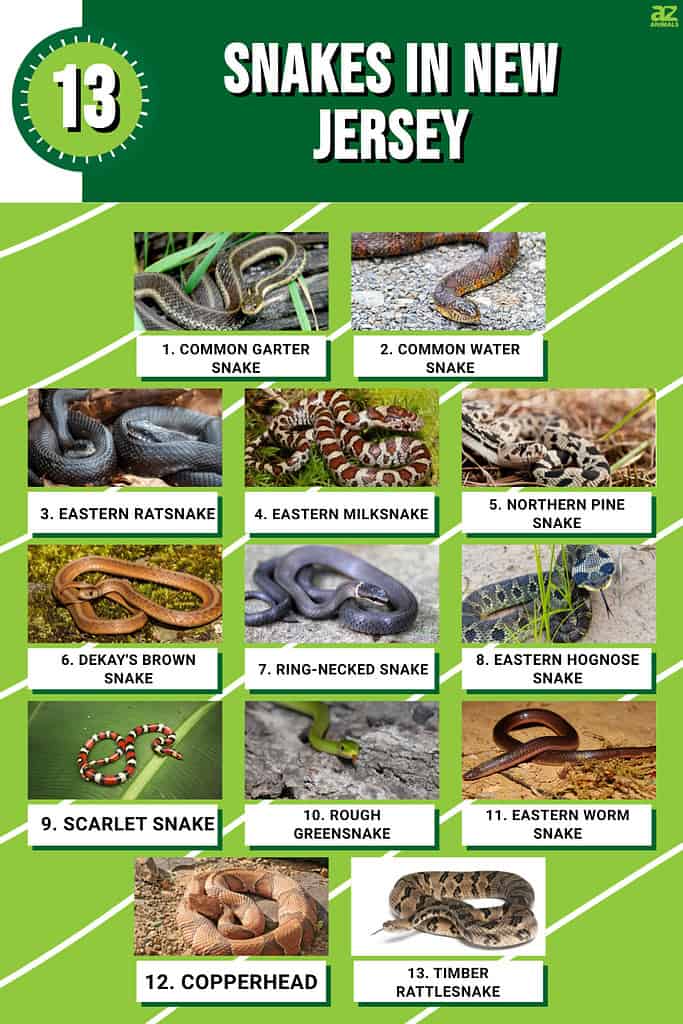
New Jersey’s approximately 22 snake species vary widely in size and appearance. From the tiny ring-neck snakes and Dekay’s brownsnakes to the large and almost comical eastern rat snakes, you’ll find plenty of interesting snakes in the Garden State.
1. Common Garter Snake (Thamnophis sirtalis)

One of the most cold-tolerant snakes in the world, garter snakes are usually active early and later in the year than other species.
©Erik Agar/Shutterstock.com
The snake most New Jersey residents spot in their yards and out in nature is the common garter snake. There are several subspecies, and the most likely candidate in the state is the eastern garter snake. However, it’s tough to tell which subspecies is which with these snakes, so it often comes down to location and scale counting.
Common garter snakes usually average about two feet long but can reach a little over four feet. Most have yellow stripes over a brown, black, or green base color. These thin snakes are semiaquatic daytime predators that spend most of their time in or near the water.
This species is widespread across New Jersey, and many people find them in the garden bushes, where it’s nice and moist. Garter snakes eat a variety of small fish, amphibians, and earthworms.
2. Common Water Snake (Nerodia sipedon)
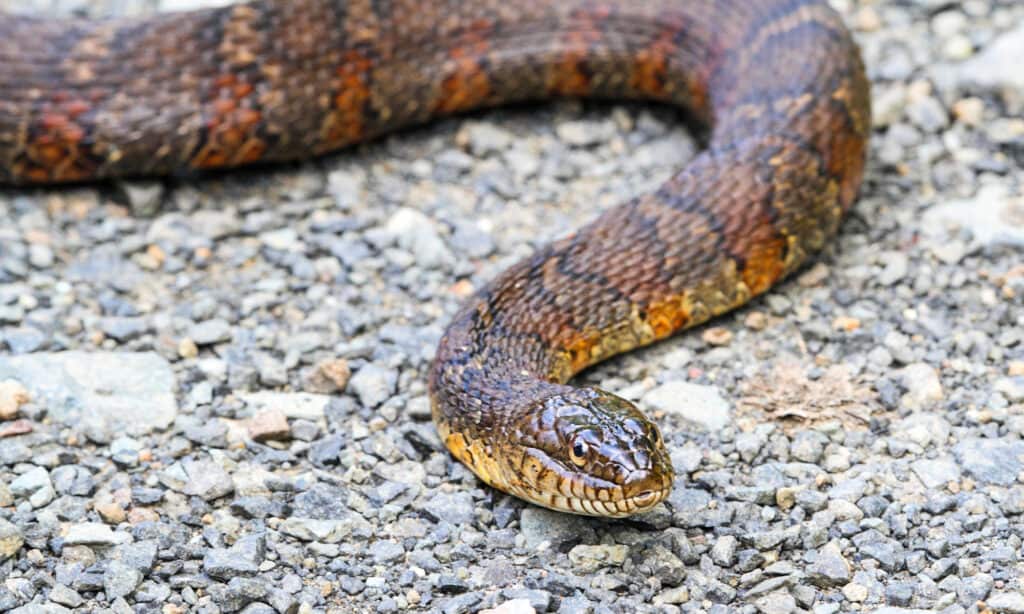
Northern watersnakes are one of the most widespread watersnakes in North America.
©Steve Byland/Shutterstock.com
An appropriately named snake, common water snakes are the most widespread of any of the Nerodia water snakes. They live in most of the rivers, lakes, and ponds in eastern North America — there’s hardly a water body without them in New Jersey. Common water snakes eat amphibians, small fish, sometimes tadpoles, and other small animals.
These snakes have reddish-brown markings that extend all the way down their bodies. Near the neck, they’re bands and become blotches with alternating vertical bars that come up from the belly. Their colors become darker as they age, and some individuals become so dark that the pattern is nearly invisible.
Common water snakes grow between two and four feet long, are thick-bodied, and have keeled scales, much like venomous copperheads and rattlesnakes. However, venomous snakes in New Jersey aren’t water-loving and only swim as needed.
3. Eastern Ratsnake (Pantherophis alleghaniensis)
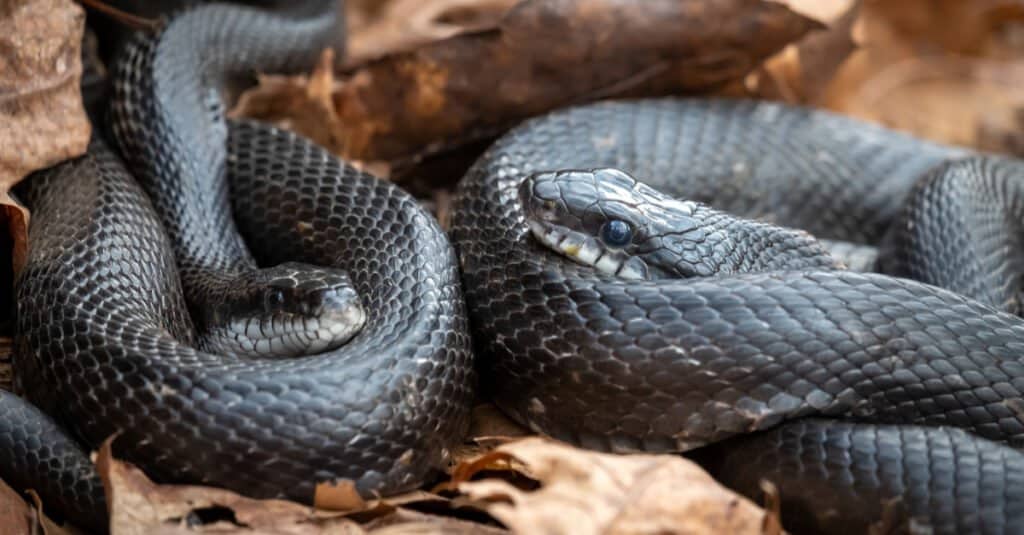
Eastern ratsnakes are some of nature’s best pest control.
©samray/Shutterstock.com
Also called black rat snakes, these snakes thrive anywhere they can find food and shelter. They’re known for doing odd things like climbing up walls, getting into kitchens, and staring you down from your garage rafters. However, if they’re in your home, it’s because they smell food.
Eastern rat snakes are harmless colubrids, although they’d like you to think they’re the biggest, baddest rattler out there. In a move similar to the gopher snakes, eastern rat snakes coil up, rattle their tails, and even strike at you. Except, unlike gopher snakes, the eastern rat snake will bite you. Of course, they’re harmless, but they just want you to leave them alone. If you have to move it from your home or garage, it’s usually fine to pick up — once they’re in your hands, they usually settle down.
These outstanding climbers are as comfortable cruising through the trees as they are on the ground; you never really know where you’ll find one. Adult eastern rat snakes are usually black with remnants of their juvenile pattern that often look like flecks of color on their bodies. Their chins have a fair amount of white, and their bellies are usually light-colored. This species gets pretty big and often grows to six feet long or more — eastern ratsnakes are common throughout most of New Jersey.
4. Eastern Milksnake (Lampropeltis triangulum)
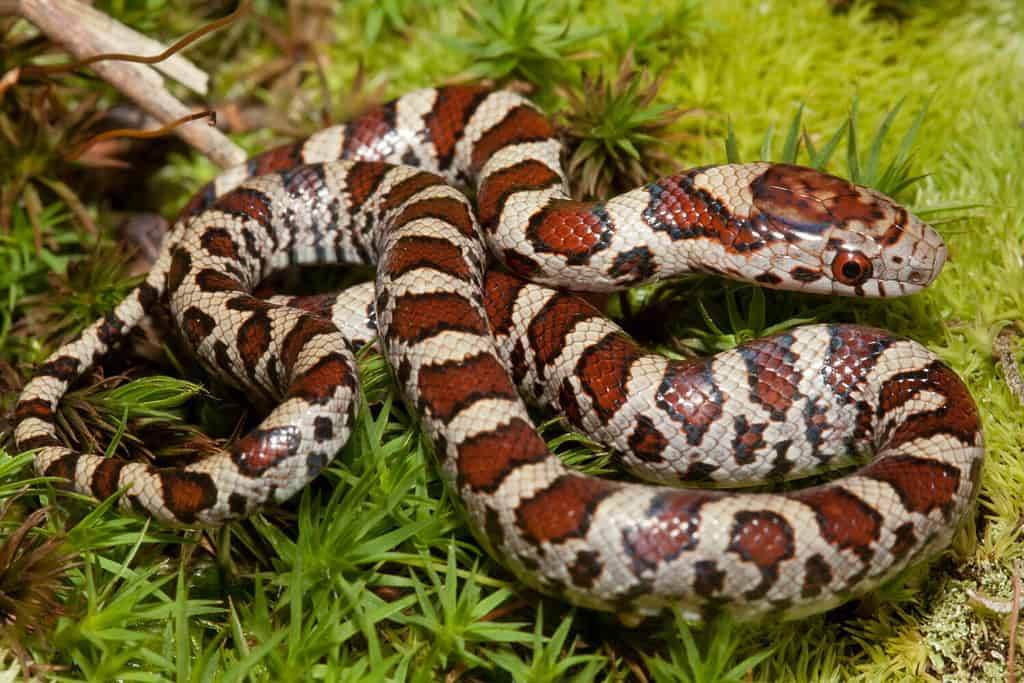
Milksnakes are a type of kingsnake and sometimes eat other snakes.
©Nathan A Shepard/Shutterstock.com
We call them milksnakes, but they’re a type of kingsnake. Eastern milksnakes got their name because they often take shelter in barns near the milk cows — leading to the mistaken belief that they suckled from the cows. They typically live in forests or open woodland but are adaptable and also occur in swamps, on rocky slopes, and even on sand dunes near beaches.
Eastern milksnakes have beautiful patterns of reddish-brown blotches over a light brown base color. These nonvenomous, harmless snakes can sometimes grow to six feet long, but it depends on which subspecies — some are bigger than others. Eastern milksnakes various prey, including insects and earthworms, when they’re small, graduating to rodents, lizards, snakes, birds, and eggs as they mature.
5. Northern Pine Snake (Pituophis melanoleucus)
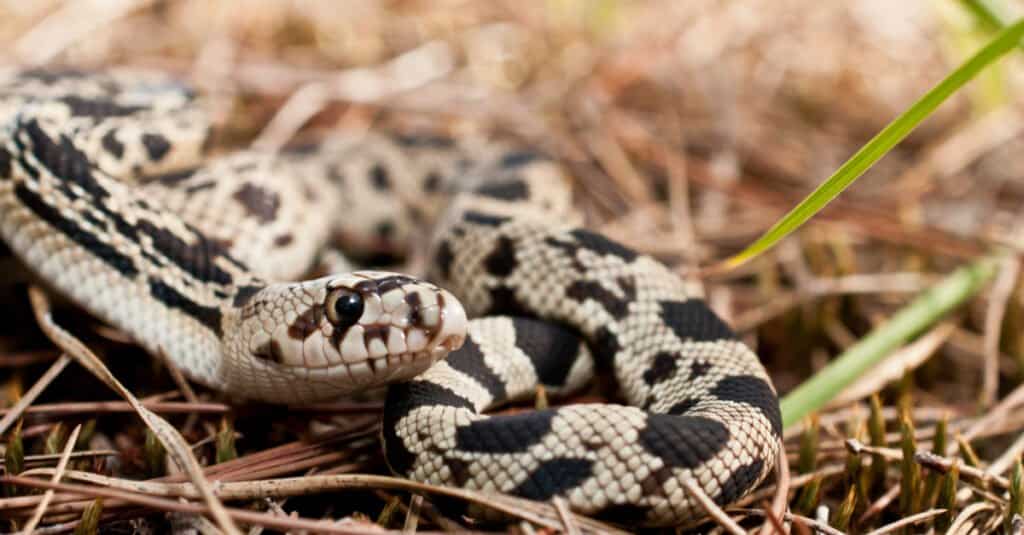
Northern pine snakes are closely related to gopher snakes.
©Jay Ondreicka/Shutterstock.com
The northern pine snake inhabits the southern half of New Jersey, where it prefers sandy soils without much vegetation. It uses this substrate to burrow using an enlarged scale on its snout for brumation and nesting sites, but also for shelter from the summer heat.
Like most snakes, northern pine snakes try to avoid people. They hide, taking advantage of their camouflage to escape detection before making an escape — a pretty impressive feat for a snake so big because they often measure over seven feet long. These snakes have black, brown, or reddish-brown blotches over a lighter brown or tan base color and have smallish heads.
Northern pine snakes are in the same genus as gopher snakes and use some of the same defensive tactics. When cornered, they sometimes flatten their head and hiss loudly while rattling their tail against the ground or in leaf litter. Pushed far enough, they’ll strike. However, these nonvenomous snakes can’t do any real damage to you.
Far from being a dangerous snake, northern pine snakes help keep rodent populations in check and will sometimes clean out entire nests.
6. Dekay’s Brown Snake (Storeria dekayi)

Dekay’s brownsnakes have a light-colored dorsal stripe.
©Jay Ondreicka/Shutterstock.com
Dekay’s brownsnakes are small. The biggest one on record measured just over 19 inches! However, adults are usually less than 12 inches long. They’re one of a handful of snakes that are often found in a suburban or semi-suburban environment. Dekay’s brownsnakes eat snails, slugs, and earthworms, so they often hide under rotten logs, leaf litter, or the mulch in your garden.
These snakes typically have a brown or gray base color with a lighter dorsal stripe flanked by small black dots. Many also have two black bars behind their heads and lighter brown or pink bellies. They’re more common in western New Jersey but can be found statewide.
7. Ring-Necked Snake (Diadophis punctatus)
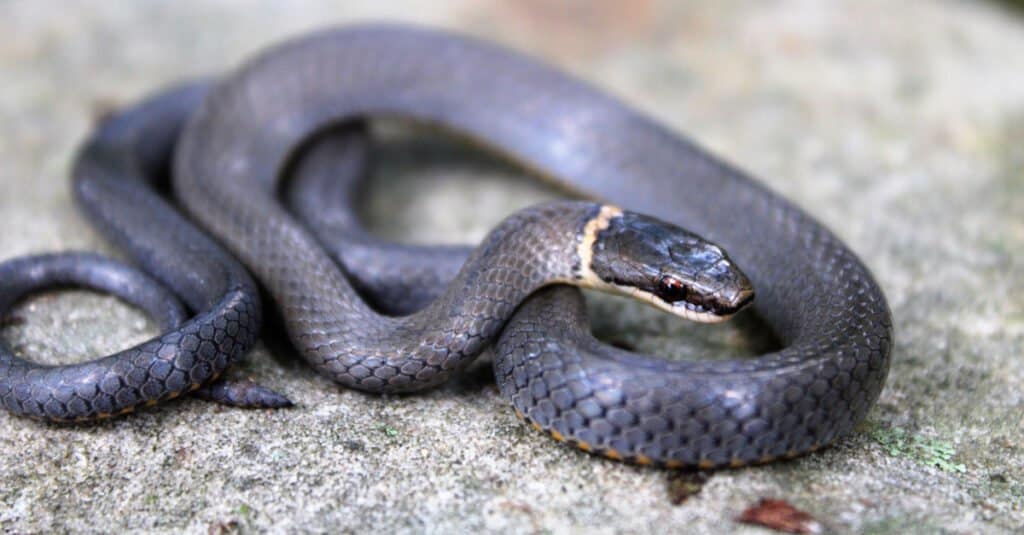
Ring-necked snakes (Diadophis punctatus) are nocturnal and hide under rotten logs or leaf litter.
©Tucker Heptinstall/Shutterstock.com
These little snakes are probably within 100 yards of your feet, and you’ll never even see them. Ring-neck snakes are widespread across New Jersey and hide under rotten logs, leaf litter, wet mulch, and other moist places where their prey hides. Much Like Dekay’s brownsnake, ring-neck snakes are slug and earthworm eaters that also eat small salamanders, lizards, frogs, and even smaller snakes.
Ring-neck snakes are solid-colored on their dorsal side and can be gray, black, or olive green. Their bright orange, red, yellow, or white bellies and matching neckbands make them easy to identify.
8. Eastern Hognose Snake (Heterodon platirhinos)
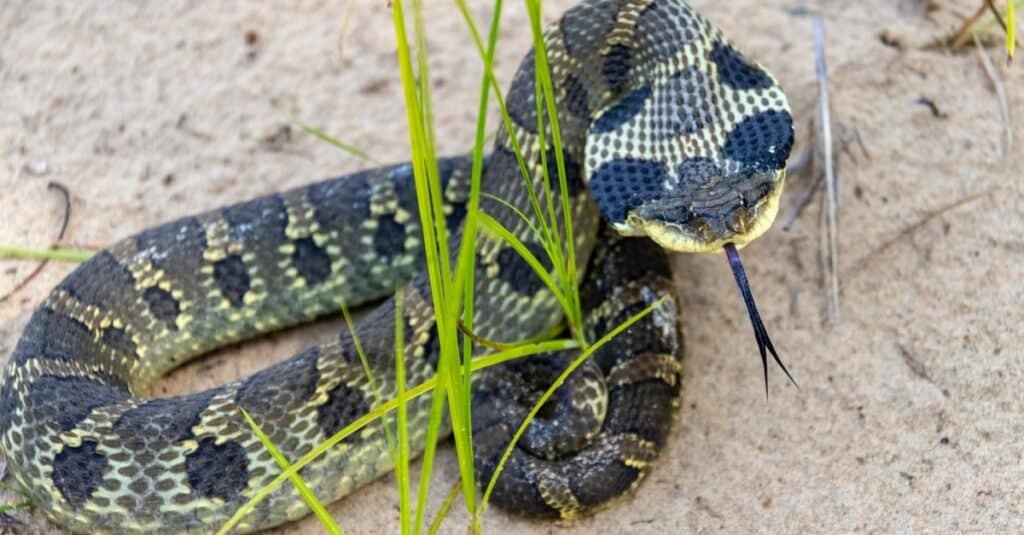
Eastern Hognose Snake with a flattened neck on sandy soil with grass. The eastern hognose snake will flatten its head and neck and hiss loudly when threatened.
©IHX/Shutterstock.com
New Jersey’s also home to one of the snake world’s most famous drama queens. The harmless eastern hognose snakes’ defensive display is impressive by any measure. When threatened, these two-foot-long snakes start by spreading out their tiny hoods to look a little bigger. Failing that, hognoses go through an elaborate death-feigning routine which includes writhing around on the ground, turning over onto their back, and leaving their mouths wide open and tongues hanging out.
If you stay long enough and watch, it’ll come right back to life and slither off. Here’s the funny thing, it sometimes looks as though the hognoses peek around before deciding whether to continue the charade.
Eastern hognose snakes eat toads — and lots of them. They’ll also eat other amphibians, but these are toad specialists that have a resistance to the toads’ toxins. Some scientists speculate that because of their diet, hognose snakes may actually be poisonous — in addition to their mild prey-specific venom.
Most adult hognose snakes average about two feet long, but they can reach four in rare cases. These snakes have dark blotchy markings over a base color that ranges from orange or red to even black. The most unique feature all the eastern hognose snakes share is their upturned snout which gives them their common name.
9. Scarlet Snake (Cemophora coccinea)
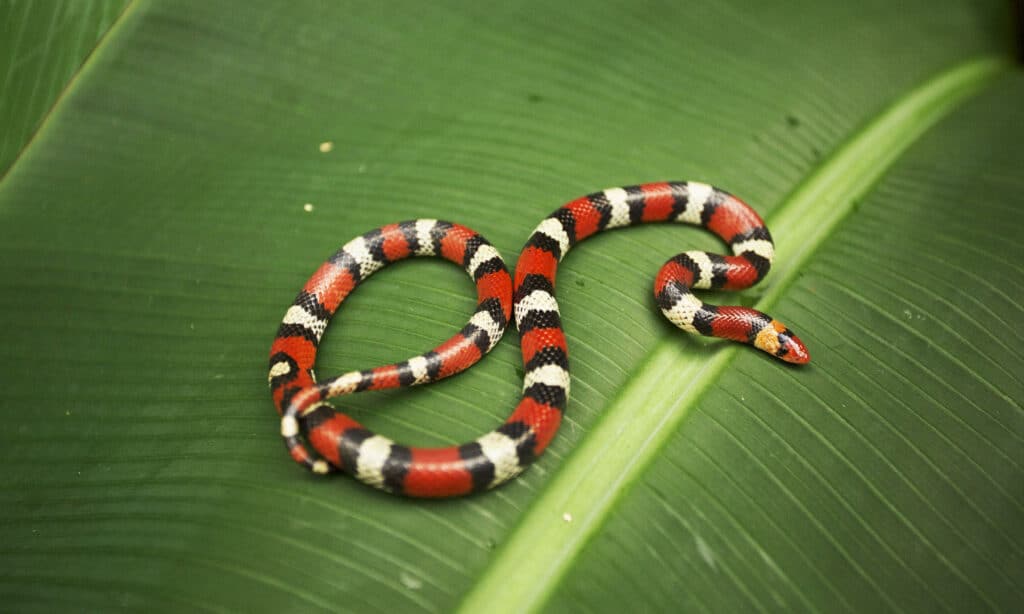
Scarlet snakes are common in the eastern U.S.
©Fine Art Photos/Shutterstock.com
Scarlet snakes are uncommon in New Jersey. It’s at the northern end of their range, and although they can technically be found throughout most of the state, they’re more common in the southern two-thirds.
This nonvenomous colubrid looks much like a kingsnake, but they’re more slender and have a pointier snout. Scarlet snakes are small and only measure 14-26 inches long. They have red, yellow, or white black-bordered dorsal blotches that often look like bands because they extend downward toward the snake’s belly, which is usually solid yellow or white.
There aren’t any native coral snakes in New Jersey, so even though they look like those venomous snakes, they’re not. Scarlet snakes are active at night and hide under logs, pine debris, and other ground cover during the day. They mainly eat lizards, lizard eggs, turtles, other snakes, and toads.
10. Rough Greensnake (Opheodrys vernalis)

It is easy to identify younger snakes because of the blue dots that are on their head.
©iStock.com/Shoemcfly
Also called grass snakes because of their color, rough green snakes are nonvenomous natives to eastern North America. They’re most common in southern New Jersey, where they blend in so well that people don’t always see them.
Rough greensnakes are very thin, bright green with yellowish to white bellies that grow nearly four feet long. Their main habitats are woodlands and moist meadows with trees to climb because they are extremely arboreal.
Their diet usually includes insects and other arthropods, but they’ll also take a tree frog or snail as they see fit. Rough greensnakes aren’t aggressive and almost never bite. Fortunately, they’re harmless, so even if they bite you it won’t do damage.
11. Eastern Worm Snake (Carphophis amoenus)
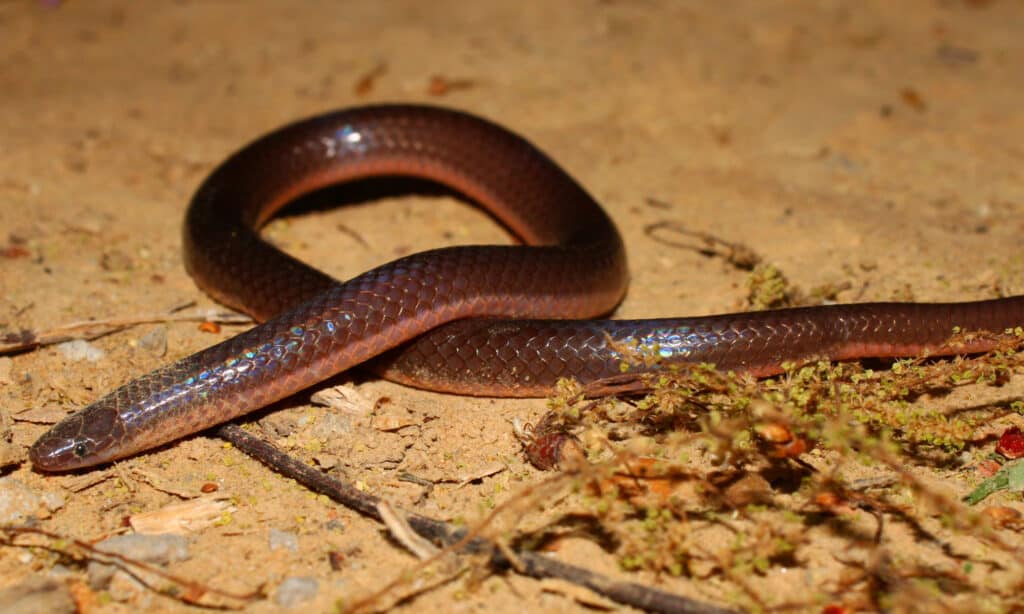
©Jason Patrick Ross/Shutterstock.com
This tiny snake only grows to about 11 inches long from snout to tail. Eastern worm snakes are so small and innocuous that you might mistake them for worms until you look closer. They’re harmless nonvenomous snakes that are common, but seldom seen because they’re underground most of the time.
Eastern worm snakes are solid brown with pink bellies and have spine-tipped tails that they sometimes use to help hold prey still. They eat earthworms and other soft-bodied insect larvae. These snakes spend all of their time burrowing under moist leaf litter after prey. Their skin is extremely porous and releases moisture quickly, so the soil they burrow in must have enough to keep them from dehydrating.
12. Copperhead (Agkistrodon contortrix)
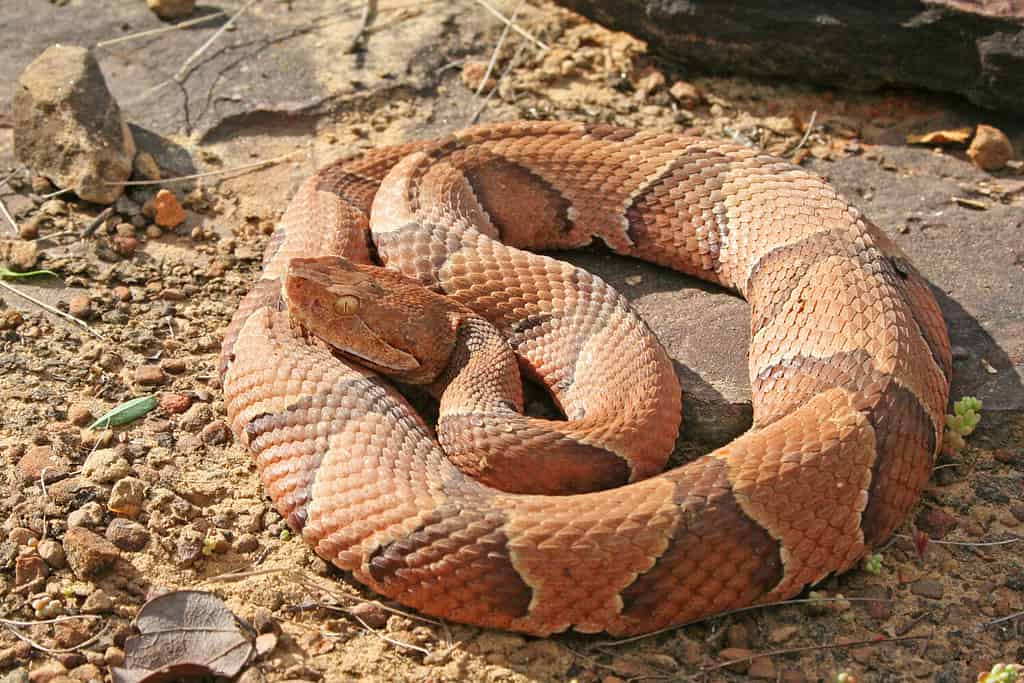
Copperheads get their name from the color of their head, which is a copper-bronze color.
©Creeping Things/Shutterstock.com
Of the approximately 8,000 venomous snakebites in the U.S. each year, copperheads are responsible for nearly half. Fortunately, scientists say that their venom is less dangerous than that of other pit vipers, and most people recover completely without lasting damage.
Copperheads are pit vipers, like nearly all other venomous snakes in North America — the only venomous snakes that aren’t pit vipers in North America are coral snakes.
Notable for their chocolate kiss markings, copperheads have a lighter base color of tan to pink with a copper-colored head. When they’re born, copperheads have bright yellow or green tail tips that they sometimes use as a lure for prey. As adults, these snakes rarely grow beyond three feet in length and keep their pattern.
These snakes eat a variety of small prey including invertebrates like cicadas, in addition to small rodents, amphibians, and other reptiles. Unlike many snakes, copperheads freeze in place, which is part of why they’re responsible for so many bites every year — they get stepped on by unsuspecting hikers.
Copperheads prefer wooded areas where they can camouflage in the leaf litter, which is perfect for their markings. Those chocolate kisses merge almost seamlessly with the leaves.
13. Timber Rattlesnake (Crotalus horridus)
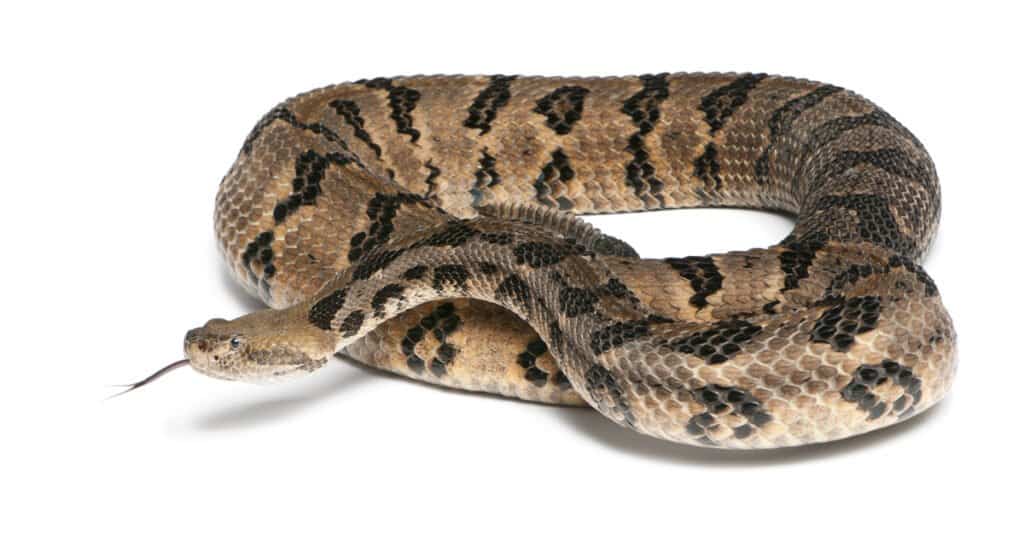
These snakes are pretty calm and don’t bite often.
©Eric Isselee/Shutterstock.com
The only other venomous snake in New Jersey is a big one! And, according to the New Jersey Department of Environmental Protection, endangered. Timber rattlesnakes can reach five feet long and are very thick-bodied. They have V or M-shaped markings over a gray-to-yellow base color. However, the further north in their range, the more common melanism becomes and you’ll find almost solid black timber rattlers.
Although this species has a very well-developed rattle, they are calm snakes and only use it when threats get very close. Bites are rare unless they are severely harassed or just stepped on because they rely on their excellent camouflage and don’t always move out of the way.
Once common across the state, timber rattlesnakes are only found a couple of populations — one in the north and one in central New Jersey. These snakes usually occur in forested areas with hardwoods and flood plains. They’ll eat small animals like frogs, birds, and other small animals. However, they’ll also eat other snakes.
Summary of 13 Snakes in New Jersey
In nearly every case, New Jersey’s snakes are completely harmless and provide a service. Some people believe that these slithering reptiles are more effective at controlling pests like rodents than cats and birds.
| Snake Name | Scientific Name | New Jersey Locale | Venomous? | |
|---|---|---|---|---|
| 1 | Common Garter Snake | Thamnophis sirtalis | Statewide | No |
| 2 | Common Watersnake | Nerodia sipedon | Statewide | No |
| 3 | Eastern Ratsnake | Pantherophis alleghaniensis | Statewide | No |
| 4 | Eastern Milksnake | Lampropeltis triangulum | Statewide | No |
| 5 | Northern Pine Snake | Pituophis melanoleucus | Southern half | No |
| 6 | Dekay’s Brownsnake | Storeria dekayi | Statewide | No |
| 7 | Ring-Neck Snake | Diadophis punctatus | Statewide | No |
| 8 | Eastern Hognose Snake | Heterodon platirhinos | Statewide | No |
| 9 | Scarlet Snake | Cemophora coccinea | Southern 2/3 of the state | No |
| 10 | Rough Greensnake | Opheodrys vernalis | Southern New Jersey | No |
| 11 | Eastern worm snake | Carphophis amoenus | Statewide | No |
| 12 | Copperhead | Agkistrodon contortrix | Western and northern New Jersey | Yes |
| 13 | Timber Rattlesnake | Crotalus horridus | Central and northern New Jersey | Yes |
The photo featured at the top of this post is © Dennis Riabchenko/Shutterstock.com
Discover the "Monster" Snake 5X Bigger than an Anaconda
Every day A-Z Animals sends out some of the most incredible facts in the world from our free newsletter. Want to discover the 10 most beautiful snakes in the world, a "snake island" where you're never more than 3 feet from danger, or a "monster" snake 5X larger than an anaconda? Then sign up right now and you'll start receiving our daily newsletter absolutely free.
Thank you for reading! Have some feedback for us? Contact the AZ Animals editorial team.






